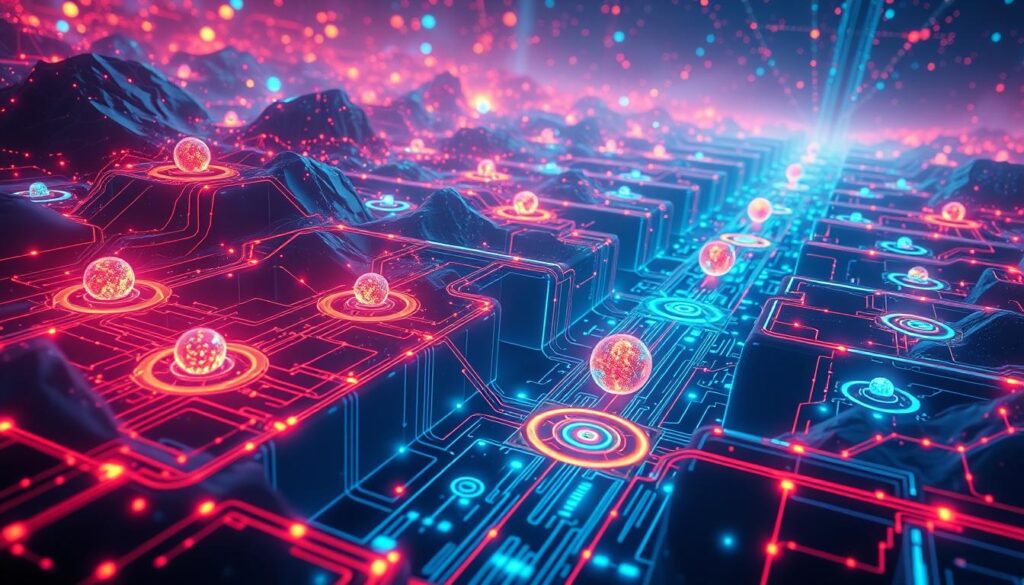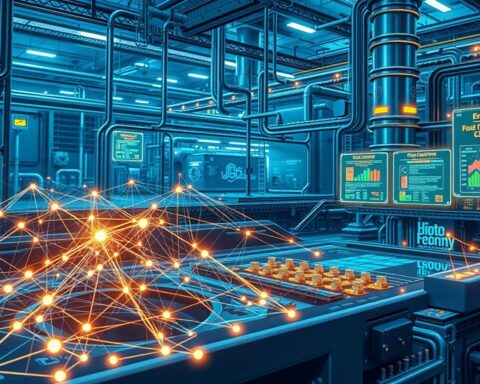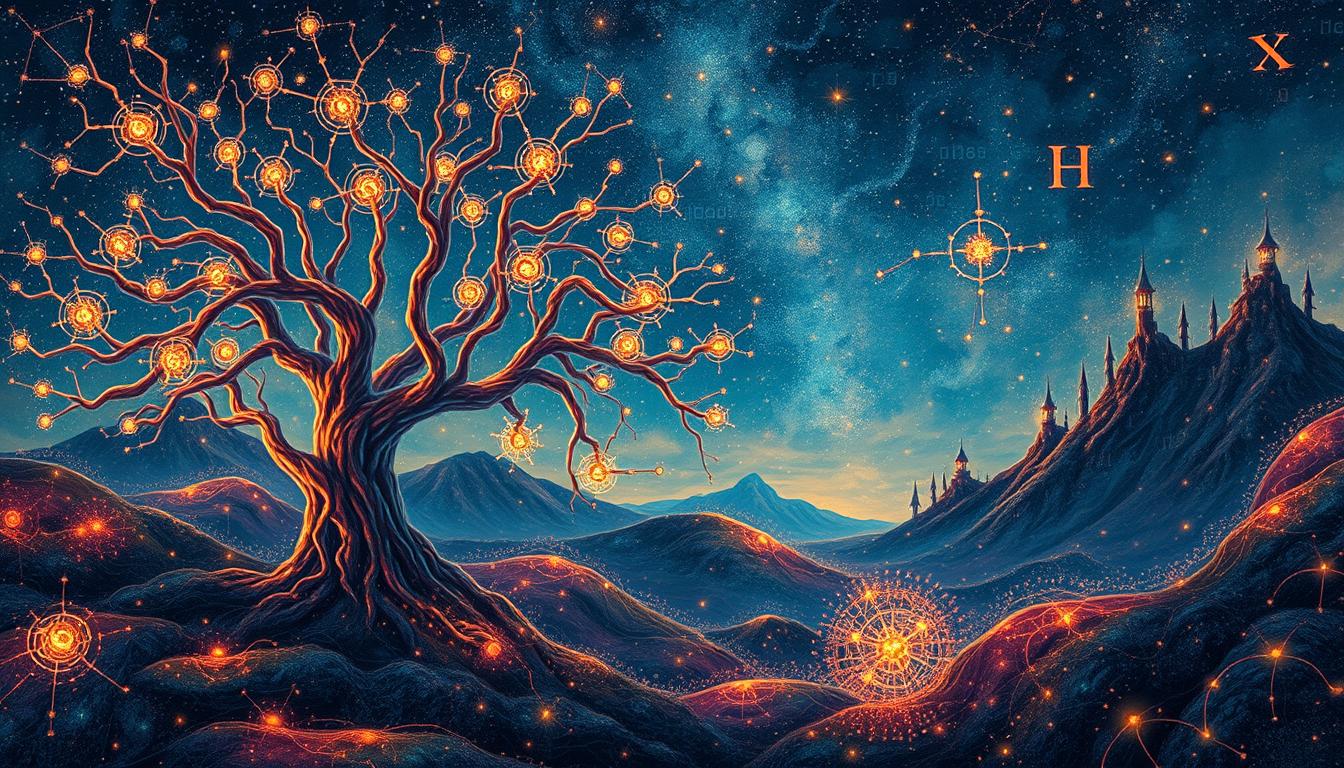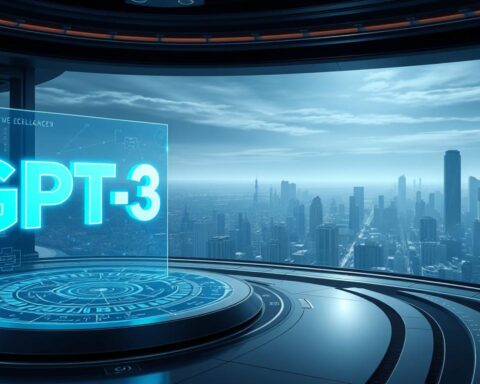Reinforcement learning is a key part of artificial intelligence. It lets agents work with their environment to get the best results1. This idea is very important for machine learning and is used in many fields like robotics and game playing.
It’s all about an agent learning to act in a way that gets it the most reward. This is a big deal in both artificial intelligence and machine learning.
Reinforcement learning: agents and rewards has become very popular in recent years. It’s used in many places, like robotics and even in games1. In January 2013, it was first used to play Atari games1. Now, it’s a key part of artificial intelligence.
Key Takeaways
- Reinforcement learning is a key area of artificial intelligence where agents interact with their environment to maximize long-term returns.
- Reinforcement learning involves an agent learning to take actions in an environment to maximize a reward.
- Reinforcement learning has numerous applications in areas such as robotics, game playing, and autonomous vehicles.
- Reinforcement learning: agents and rewards is a subfield of machine learning that has gained significant attention in recent years.
- Reinforcement learning can be used in various environments, including robotics, social behavior, media, biotech, agriculture, advertising marketplaces, digital marketing, e-commerce, and gaming1.
- Deep learning is another important part of machine learning, focusing mainly on perception1.
- Reinforcement learning usually works well with a few actions but gets harder with many1.
Understanding the Fundamentals of Reinforcement Learning
Reinforcement learning is a part of deep learning where an agent learns to act in an environment to get rewards2. It’s used to solve tough problems in many fields. The markov decision process is a math framework used to model these problems3.
An agent, an environment, and a reward signal are the basic parts of reinforcement learning2. The agent acts in the environment, and the reward signal shows how good the actions are2. The agent learns to take actions that get the most reward, which is key in reinforcement learning4.
Important terms in reinforcement learning include policy, value function, and Q-function4. Knowing these concepts helps understand the complexity of reinforcement learning. For more on reinforcement learning, check out Miloriano.com for case studies and success stories.
The following table summarizes some key concepts in reinforcement learning:
| Concept | Description |
|---|---|
| Policy | A mapping from states to actions |
| Value Function | A function that estimates the expected return of an action |
| Q-Function | A function that estimates the expected return of an action in a given state |
Reinforcement learning is used in game playing, robotics, and finance3. It’s a powerful tool for solving complex problems. Its uses are growing and expanding into new areas.
Reinforcement Learning: Agents and Rewards Explained
The agent and reward are key in reinforcement learning. The agent acts in the environment, and the reward tells if the actions are good5. The reward function is vital. It shows what the agent should aim for. Q-learning and policy gradient methods help the agent learn the best actions6.
It’s important to understand the agent and reward in reinforcement learning. The reward function is based on the current state, action, and next state. It greatly influences how the agent behaves5. Many algorithms, like Q-learning and policy gradient methods, are used to teach the agent6.
In reinforcement learning, the agent makes choices based on the reward function. For instance, in games, the reward function might reward winning or getting a high score5. The agent can use q-learning or policy gradient methods to find the best actions and get the most reward6.
Designing a good reward function is essential for success in reinforcement learning. With q-learning, policy gradient methods, and other algorithms, the agent can learn to choose actions that maximize the reward6. As the agent gets better, it can improve its performance over time5.
The Role of Agents in Reinforcement Learning
Reinforcement learning is a machine learning method. It helps an agent learn to make decisions in an environment to get the highest reward. The agent is key to understanding how this learning works7. Agents can be simple or use artificial intelligence to decide.
The agent picks actions based on the environment’s current state. This is a core part of deep learning. The interaction between the agent and the environment is vital. It affects the reward and the next environment state7. The agent must explore new actions and use rewarding ones to get the best rewards.
Agent Types and Characteristics
There are many agent types, like value-based, policy-based, and actor-critic agents. They use different methods to decide in the environment8. Value-based agents look at all states to find the best actions. Policy-based agents search for the best policies to act optimally.
The agent’s success depends on the task and data. But, with the right adjustments, they can greatly improve systems’ efficiency7. For more on reinforcement learning agents, check out reinforcement learning agents.
Reward Systems and Their Implementation
The reward system is key in reinforcement learning. It helps the agent learn by defining what it should do. The reward function tells the agent what actions are good9. To set up a reward system, you need to create a reward function and pick an algorithm like Q-learning or policy gradient methods10.
A good reward function is essential. It guides the agent’s actions and decisions. For example, a +10 reward for reaching a goal in a grid-world encourages the agent to act wisely9. A -1 penalty for each step helps the agent move efficiently9. A well-designed reward function is vital for the agent’s success in a markov decision process11.
Here are some key considerations for designing reward functions:
- Clearly define the goal of the agent
- Specify the reward signal to indicate desirable actions
- Choose an appropriate algorithm for learning the optimal policy, such as Q-learning or policy gradient methods
- Consider the trade-off between exploration and exploitation in the markov decision process
By designing a good reward function and choosing the right algorithm, developers can create effective reinforcement learning systems. These systems learn to make the best decisions in complex environments10. The reward function is a critical part of this process. Its design greatly affects the agent’s behavior and decision-making, and the overall success of the reinforcement learning algorithms11.

| Reward Type | Description |
|---|---|
| Positive Reward | Encourages desirable actions, such as +10 for reaching a goal |
| Penalizing Reward | Discourages undesirable actions, such as -1 for each step taken |
| Negative Reward | Penalizes the agent for undesirable actions, such as -10 for bumping into a wall |
Advanced Applications and Real-World Examples
Reinforcement learning is used in gaming, robotics, and business intelligence. In gaming, reinforcement learning helps create game-playing agents that can learn and make decisions12. These agents learn from their environment, just like humans do, based on rewards or penalties12.
In robotics, reinforcement learning helps robots learn to do complex tasks13. For instance, robots can learn to navigate a warehouse, making them more efficient and accurate13.
Some key uses of reinforcement learning include:
- Gaming and simulation
- Robotics and control systems
- Business intelligence and decision-making
These uses show how reinforcement learning can change industries and improve decision-making12.
Deep learning and machine learning are key to reinforcement learning. They help agents learn and make decisions based on data13. As the field grows, we’ll see more creative uses of reinforcement learning in the future.
For more on reinforcement learning applications, check out Miloriano.com. They discuss the ROI of algorithmic thinking and its business impact13.
Conclusion: Future Perspectives in Reinforcement Learning
Reinforcement learning is growing fast, with big hopes for machine learning and artificial intelligence. As deep learning gets better, we’ll see new uses and ideas. This will happen a lot in places where reinforcement learning: agents and rewards are key14.
Mixing reinforcement learning with other artificial intelligence areas like computer vision and natural language processing will lead to big discoveries. New algorithms and methods will make reinforcement learning better. This will help solve tough problems14.
Looking ahead, reinforcement learning could change many industries and make decisions better. With more machine learning and artificial intelligence, we’ll see the economy grow. It’s important for schools and companies to work together to move research forward14.
Thanks to open-source tools, getting into reinforcement learning is easier. This helps research and new ideas grow fast14. As it keeps getting better, we’ll see more progress in many fields.
FAQ
What is reinforcement learning and how does it relate to artificial intelligence?
Reinforcement learning is a part of machine learning. It helps an agent learn to act in an environment to get rewards. It’s key in AI, used in robotics, games, and self-driving cars.
What are the core components of reinforcement learning?
Reinforcement learning has three main parts: the agent, the environment, and the reward signal. The agent acts in the environment. The reward signal tells if the actions are good. The goal is to get the highest reward.
What is the role of the reward function in reinforcement learning?
The reward function is very important. It tells the agent what it should do. Algorithms like Q-learning help find the best actions for the highest reward.
What are the different types of agents in reinforcement learning?
There are many types of agents, like simple reflex agents and model-based agents. Each type makes decisions differently. Knowing about them helps understand reinforcement learning better.
What are some of the applications of reinforcement learning in real-world scenarios?
Reinforcement learning is used in games, robotics, and business. It helps make game-playing agents, control robots, and improve business processes. It has the power to change industries and make better decisions.
How does reinforcement learning relate to deep learning and machine learning?
Reinforcement learning is part of machine learning. It uses deep learning, like neural networks, to learn better. Combining it with other AI areas could lead to big breakthroughs.
What is the Markov decision process and how does it relate to reinforcement learning?
The Markov decision process is a way to solve decision-making problems in reinforcement learning. It helps the agent learn the best actions. It’s a key idea in understanding reinforcement learning.
What are policy gradient methods and how are they used in reinforcement learning?
Policy gradient methods are algorithms for finding the best policy in reinforcement learning. They adjust the policy to get the highest reward. They work well with other algorithms, like Q-learning.
Source Links
- Reinforcement Learning in the Wild and Lessons Learned – https://www.linkedin.com/pulse/reinforcement-learning-wild-lessons-learned-mohamad-charafeddine
- The Fundamentals of Reinforcement Learning and How to Apply It | Intel® Tiber™ AI Studio – https://cnvrg.io/reinforcement-learning/
- Reinforcement Learning Guide: From Fundamentals to Implementation – https://www.analyticsvidhya.com/blog/2021/10/a-comprehensive-guide-to-reinforcement-learning/
- Reinforcement learning – GeeksforGeeks – https://www.geeksforgeeks.org/what-is-reinforcement-learning/
- Key Concepts in RL — Spinning Up documentation – https://spinningup.openai.com/en/latest/spinningup/rl_intro.html
- What is Reinforcement Learning? – Reinforcement Learning Explained – AWS – https://aws.amazon.com/what-is/reinforcement-learning/
- What is reinforcement learning? | IBM – https://www.ibm.com/think/topics/reinforcement-learning
- An introduction to Reinforcement Learning – https://deepanshut041.github.io/Reinforcement-Learning/notes/00_Introduction_to_rl/
- Reward Function in Reinforcement Learning – https://medium.com/biased-algorithms/reward-function-in-reinforcement-learning-c9ee04cabe7d
- Reinforcement Learning Vs Reward Systems | Restackio – https://www.restack.io/p/reinforcement-learning-answer-vs-reward-systems-cat-ai
- Rewards in Reinforcement Learning – https://www.linkedin.com/pulse/rewards-reinforcement-learning-caleb-m-bowyer
- 9 Real-Life Examples of Reinforcement Learning – https://onlinedegrees.scu.edu/media/blog/9-examples-of-reinforcement-learning
- 9 Reinforcement Learning Real-Life Applications – https://www.v7labs.com/blog/reinforcement-learning-applications
- Reinforcement Learning: The Future of AI – https://lean-mean-learning-machine.com/machine-learning/reinforcement-learning-the-future-of-ai/










